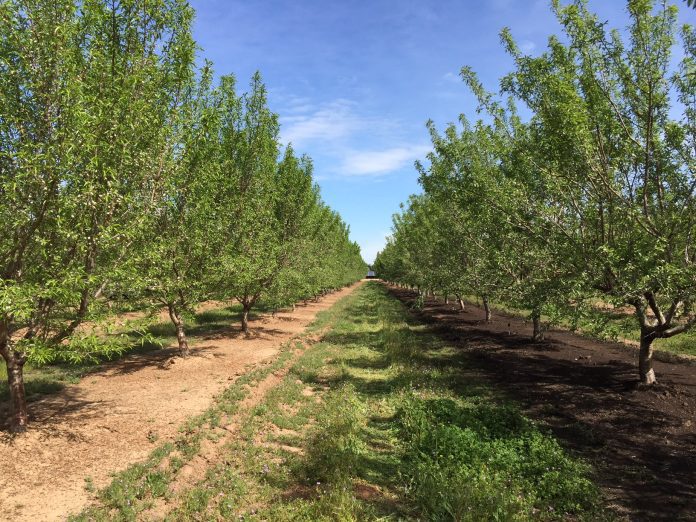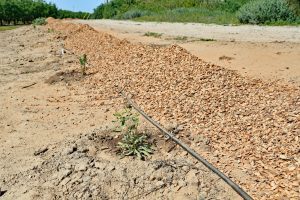
The Soil Science Society of America defines soil quality as its capacity to function effectively in the present and in the future.
Ongoing drought conditions, compacted soils and lack of water retention are some of the reasons why tree nut growers consider applying non-mineral soil amendments in their orchards to improve and retain soil quality.
The aim with soil amendments, said UCCE Farm Advisor Franz Niederholzer, is to improve soil physical and/or chemical properties as well as plant growth potential. Some soil amendments can help improve soil structure, which can increase water infiltration rates.
Certain soil amendments can increase or decrease soil pH, depending on the particular material. Some soil amendments have the potential to increase soil organic matter and improve both soil structure and water holding capacity.
“Choice of a soil amendment depends on your goals,” Niederholzer said.

Amendments vs Fertilizers
Thomas Fantozzi with Synagro said even with nutrient applications made to meet tree needs, the soil still needs organic matter to maintain health. The organic matter supplied by a non-mineral soil amendment can keep water and nutrients available to the trees. Mineral amendments are directed more at correcting soil deficiencies.
Mineral soil amendments can provide plant nutrition, but they are not considered to be fertilizers.
The Western Fertilizer Handbook (ninth edition) notes that amendments are any material worked into the soil to make it more productive. Fertilizers can fall into that category but do not always improve soil health, contribute water holding ability or improve water infiltration.
Fantozzi said that growers typically look at soil amendment applications when trees are not performing as expected. Soil tests, leaf tissue analysis and water tests can show adequate levels of nutrients, but the soil itself can be lacking in ability to provide an environment that fosters good tree growth.
“When trees are not performing up to par, growers will look at soil amendments to improve production,” Fantozzi said. He works with almond growers who make annual compost applications in their orchards. They report yield improvements depending on their soil starting point, he added.
Selecting an Amendment
Factors to consider when selecting a soil amendment include how long the amendment will last in the soil, soil texture, soil salinity and tree sensitivity to salt, and salt content and pH of the amendment. To be as effective as possible, a soil amendment must be incorporated into the soil.
It should be noted that soil amendments and applications are not regulated, and products can have a high salt content.
An amendment to quickly improve soil physical properties should rapidly decompose. For longer soil remediation, the amendment should decompose slowly. A combination of the two may achieve both goals.
Fantozzi, who is also an almond grower in the Patterson area, said it is a typical practice to apply soil amendments after harvest and prior to fall or winter rain. Building a productive soil, not just for the next year but over time, is the goal.
There is less orchard equipment moving through following harvest, he said, and applying an amendment like compost or a compost blend following harvest will allow applications before fall or winter rains. This is important in orchards with drip systems as they need rain to move the amendments deep into the soil.
Broadcasting the amendment on the soil and irrigating it in is an alternative to water applications. Timing is important. Applying an amendment to improve infiltration too early in the spring reduced efficacy. Surface applications are most effective when applied monthly during the summer months. Compost blends with mineral amendments can also be applied in a two-foot-wide band along the tree row.
Compost
UC’s Solution Center for Nutrient Management defines compost as the product of controlled biological decomposition of organic material. The process involves heat generation sufficient to eliminate pathogens as well as stabilize the organic material at a stage where it can be applied to soil.
UCCE Biological Systems Engineer David Crohn reported that important factors in evaluating compost quality include carbon to nitrogen ratio, organic matter content, salts, stability, pH and maturity. A U.S. Composting Council seal is a guarantee that the compost has been sampled and tested and meets the council’s quality requirements.
The material being composted, the composting process and length of the process all determine the quality of the final product.
While compost applications are made primarily to enhance soil structure, there is no evidence that applications in tree nut orchards of composted green waste or composted manure increased almond tree growth or yields. UCCE pomology advisor Roger Duncan said that results of a five-year trial were not significantly different among amendments. Measurements of stem water potential found no differences between trees that received compost applications and those that did not. He also reported to West Coast Nut that cost for compost purchase, delivery and application at 10 tons per acre was about $265 annually or $1,325 per acre over the five-year trial.
Biochar
Biochar is a carbon-rich material produced via thermochemical conversion of biomass in an oxygen-limited environment. It is also an umbrella term for the many types and categories produced, Sanjai Parikh from UC Davis’ Department of Land, Air and Water Resources said. Pyrolyzed biomass has properties that are a function of production variables, including gasification, feedstock, residence time and production temperature. It can also be a fertilizer if made from manure.
Biochar use in tree nut orchards has not been studied, Parikh noted, due to length of time needed to measure results, unlike annual field crops.
Biochar is considered a soil conditioner, Parikh said, and may provide different benefits. Not every biochar, he cautioned, will provide the benefits sought.
“It must be tailored to match soils and climate to achieve the benefits,” he said.
Like compost, use of biochar in a tree nut orchard would depend on goals of the grower.
Parikh said biochar applied to soil can add organic nutrients that plants and soil microbes can use as a food source. It also can improve soil structure, subsequently improving water movement.
Biochar is typically broadcast on soil surface and tilled in, but Parikh noted subsurface banding may be more efficient in concentrating it in the crop rhizosphere and minimizing dust. Unlike other non-mineral soil amendments, biochar is persistent in the soil and does not need to be applied annually.
By-Products as Amendments
Studies conducted by UC Davis Horticulture and Agronomy Group Ph.D. candidates Ellie Andrews and Sire Kassama show that almond hulls and shells applied as organic amendments to soils release potassium into the soil. The release of potassium is driven by water application, not decomposition, but their recent work showed that this practice can increase soil exchangeable potassium with benefits to July leaf potassium values. Release of potassium sets these by-products apart from other organic soil amendments.
In the long-term, hull and shell soil applications could be used with other soil amendments to build soil organic matter and reduce dust and erosion.










